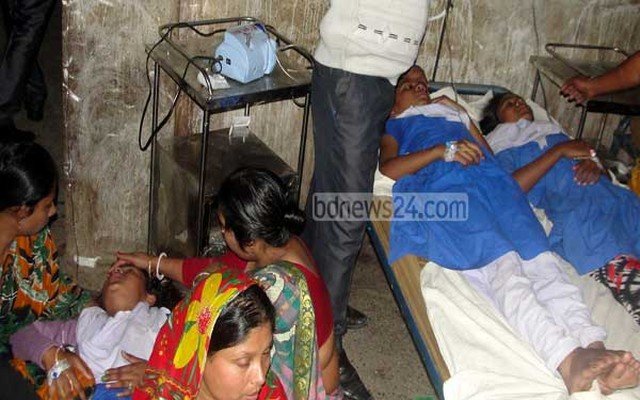According to the English-language Bangladeshi newspaper bdnews24.com:
"It was just another day at Shibram RD Academy School in Faridpur until student Ritu Saha started experiencing difficulty while breathing. Even as she was administered first aid, 37 of her classmates also reported similar symptoms. Academy's teacher Susanta Kumar said all the students were evacuated from the classrooms and gathered in the playground. Meanwhile, 30 other students, mostly girls, also fell sick.... Supervisor Ganapati Biswas said that... hundreds of students, mostly girls between Class 6 and 10, have been affected. The disease starts with a student feeling out of breath, with the rest developing symptoms driven by anxiety that rippled through the school."The students were taken to a local college hospital and examined, but doctors there could find no common cause or reason for the symptoms. In all the cases the mystery illness was minor and soon faded away.
In all, 57 schools in the region were closed for two days while investigators searched for a cause but none was found. The Faridpur school mystery has all the textbook signs of a mass hysteria outbreak.
Understanding Mass Hysteria
Mass hysteria is often misunderstood as being an illness that sufferers are making up. In fact the symptoms are verifiable and not imaginary. The issue is instead what is causing the symptoms—whether some external environmental contaminant or instead a form of suggestion-driven social contagion.
Humans are social animals and we often take our cues from other people, both consciously and unconsciously. Research has shown, for example, that yawning and moods can be contagious. In the same way, people can unconsciously mimic the actions and reactions of their peers; if one or more of them start to faint or feel sick in their presence it can create a domino effect, spreading to others.
Outbreaks of mass hysteria (also known as mass sociogenic illness) are most common in closed social units such as schools and factories where afflicted individuals have strict routines and are under stress.
Symptoms of mass hysteria are typically both minor — such as shortness of breath, fainting, nausea, and headache — and short-lived, lasting anywhere from a few minutes to a few hours. Because there is no physical irritant to treat or remove from the patient, there is no real treatment other than attention from doctors, parents, teachers or other authorities.
The fact that no further reports have surfaced from the Faridpur district schools is strong evidence that the mass hysteria diagnosis is correct. This is because nothing had been done to the schools during the closing, so there was no change in the conditions before and after the outbreak.
Had the breathing difficulties been caused by some environmental agent or toxin—a gas leak, chemical spill, or mold spores, for example—the students would have once again come down with the symptoms upon returning to the affected schools.
Since the illness was spread through social interaction, the most effective way to deal with the outbreak was to close the schools, thus limiting students' interactions with each other. Isolating the students outside of school in a quarantine — for example preventing them from seeing friends or siblings until the school reopened — would be even more effective, but impractical to enforce.
Supervisor Biswas's reaction serves as a model for other school administrators in dealing with suspected cases of mass hysteria: investigate thoroughly and shut down the school for a few days to calm the community's fears.




Comment: See also: Schoolgirls' Mystery Illness: Mass Hysteria or Environmental Toxin?